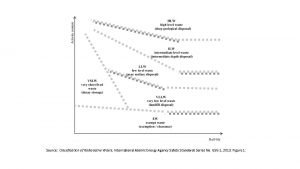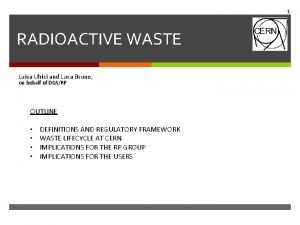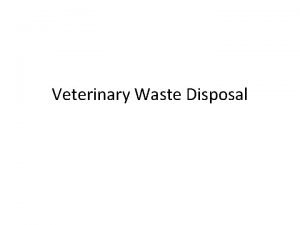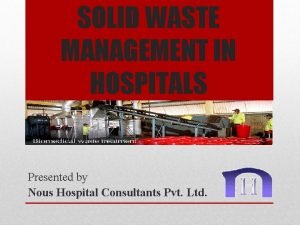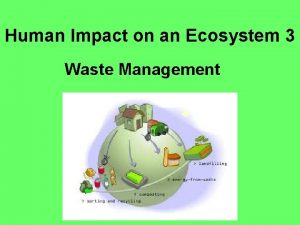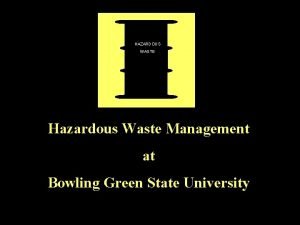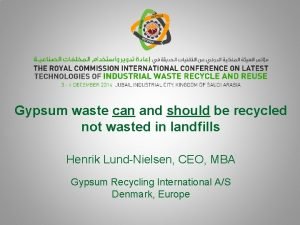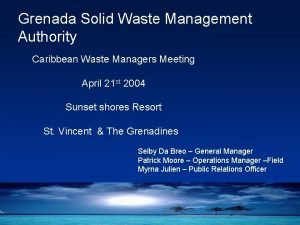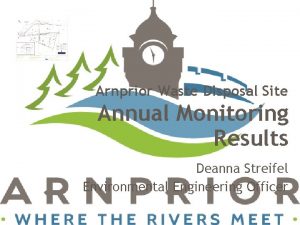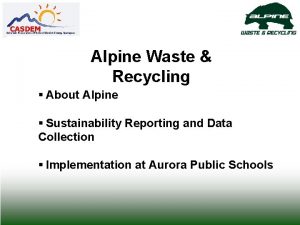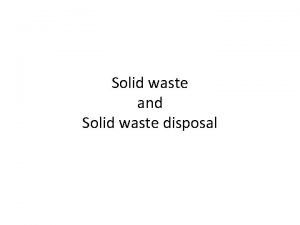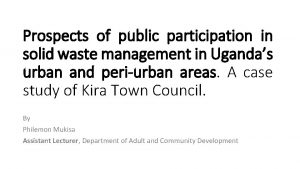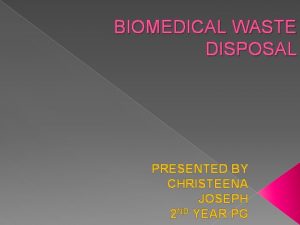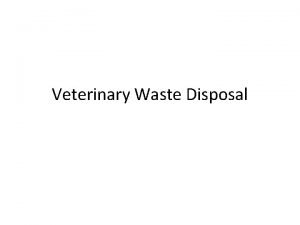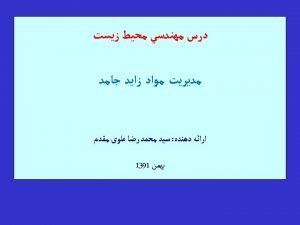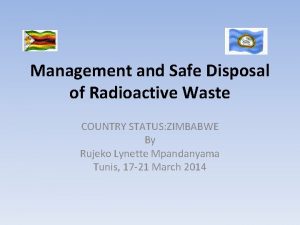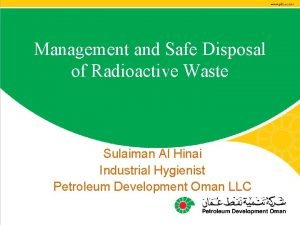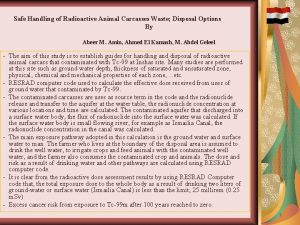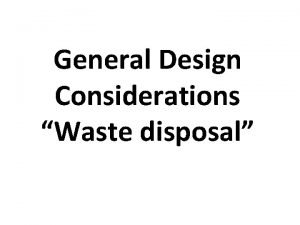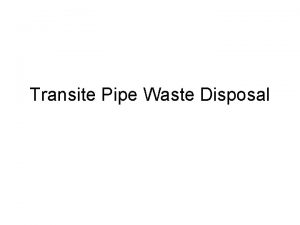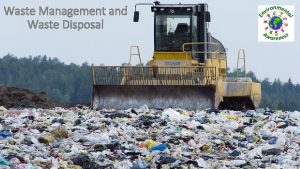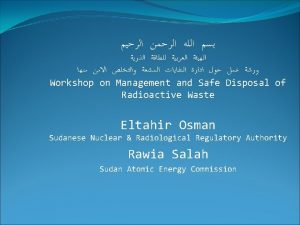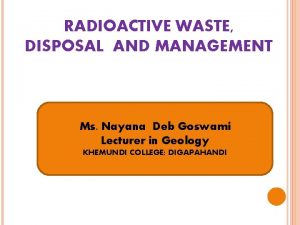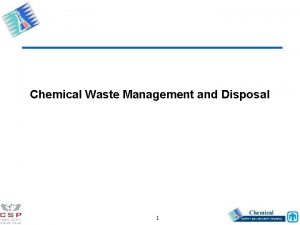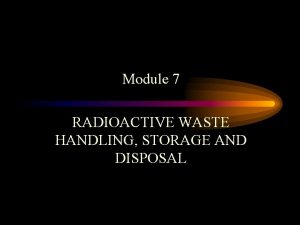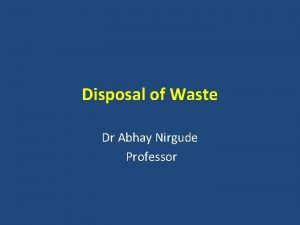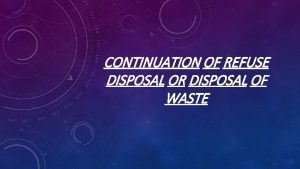Waste Management and Safe Disposal of Radioactive Waste



















- Slides: 19

Waste Management and Safe Disposal of Radioactive Waste In Iraq

Introduction Radioactive waste in Iraq arises mainly from decommissioning of destroyed nuclear facilities and waste related to previous nuclear research programs as well as that related to the waste generated from nuclear activities in medicine, In addition to the wastes coming from DU wastes and NORM. Therefore the radioactive waste shall be managed in the true spirit of national objectives laid down in the National Policy and Strategy on Radioactive Waste Management, and applicable national Laws and Regulations of the country.

Objective The objective of this presentation is to evaluate the inventory of all types of radioactive waste in Iraq, irrespective of its origin , and how will be managed , classified, and stored or disposed to ensure safety of public and the environment.

Radioactive waste in Iraq arises mainly from: 1 - decommissioning of destroyed nuclear facilities during the Gulf war 1991 (11 sites) mainly in Al-Tuwaitha. 2 - Waste related to previous nuclear research programs as well as the waste generated from nuclear activities in medicine.

3 -Waste caused by DU weapons and NORM generated from various industrial activities as by-product in the country, specially from oil industry. Therefore the radioactive waste shall be managed under the National Policy and Strategy of Radioactive Waste Management and applicable National Laws and Regulations of the country.

Map of destroyed nuclear facilities around Iraq

Al Tuwaitha Site







Radioactive waste inventory in Iraq There is no exact inventory of all radioactive waste amounts in Iraq, but it will be evaluate step by step during the decommissioning process, as well as the DU and NORM waste. In general radioactive waste inventory in Iraq as below: 1 - The estimated quantities of currently solid radioactive waste (about 1054 ton) and liquid ( about 156 m 3 ). 2 - The expected amounts and types of the waste coming from decommissioning activities can't be estimated at present, but most of the expected types of wastes will be mainly VLLW and LLW.

3 -Radioactive wastes in hospitals. 4 - Legacy wastes: Legacy wastes coming mainly from previous nuclear activities. 5 - NORM and TNORM wastes: Naturally occurring radioactive materials (NORM) occur as waste in Iraq from activities such as oil and gas extraction and production. 6 - DU wastes: DU wastes coming from contaminated tanks and military equipments destroyed by DU weapons during the Gulf Ware, which distributed mainly in south and middle of Iraq. 7 -Disused Radioactive Sealed Sources (DRSS): There are more than 4000 radioactive sources lost in Iraq. Some of them were collected and stored in Tuwaitha Site.

Waste Classification: Such classification is based on the half life time and activity concentrations of radio nuclides contain: 1 -Very Short Lived Waste (VSLW) 2 -Very Low Level Waste (VLLW) 3 - Low Level Waste (LLW) 4 -Intermediate Level Waste (ILW) 5 - High Level Waste (HLW) 6 -Disused Sealed Radioactive Sources (DSRS) Sealed Radioactive Sources Containing Long Lived

Waste Management Techniques Radioactive waste shall be processed in such a way that the resulting waste, packaged, or unpackaged, can be safely stored and retrieved from the storage facilities for disposal. Waste conditioning and waste disposal for managing various types of radioactive waste. The selected options shall be based on technical and economical viability.

Very low level waste (VLLW) is waste that is low in activity concentration but contains some longer lived radio nuclides. Its activity concentration does not usually exceed one hundred times clearance levels for each of the radio nuclides concerned. Such waste generated mainly during the operational, decommissioning and dismantling stages of a nuclear facility. Typical VLLW includes concrete, soil and rubble.

Thanks for listening
 Conclusion of radioactive pollution
Conclusion of radioactive pollution Radioactive nuclear waste
Radioactive nuclear waste Radioactive waste
Radioactive waste Lindsay waste collection
Lindsay waste collection Veterinary waste management
Veterinary waste management Color coding for waste disposal
Color coding for waste disposal Waste disposal lyndon
Waste disposal lyndon 3 waste segregation
3 waste segregation Biomedical waste management definition
Biomedical waste management definition Waste manifest
Waste manifest Disposal of gypsum waste
Disposal of gypsum waste Grenada garbage service
Grenada garbage service Arnprior waste disposal site
Arnprior waste disposal site Alpine waste disposal
Alpine waste disposal Summary of biomedical waste management
Summary of biomedical waste management Controlled tipping is a method of disposal of
Controlled tipping is a method of disposal of Solid waste disposal introduction
Solid waste disposal introduction Bio medical waste management introduction
Bio medical waste management introduction Veterinary waste disposal legislation
Veterinary waste disposal legislation Solid
Solid

